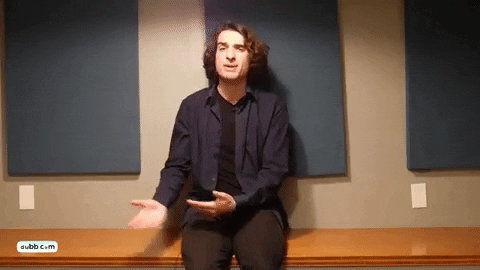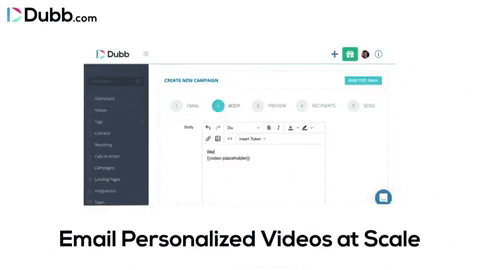Have you been searching for ways to learn more about leadership in 2021? As we start this new decade, it’s really important to strengthen our leadership skills—no matter the size of your team. Whether you are the CEO of your startup or recently obtained a leadership role at your company, it is worth your time to both study this topic and put your new ideas into practice.
Because of this, I am glad that you are here. In this video from the Dubb Action Summit, Dubb Creative Director Shannon Leonard and I discussed how empathy, storytelling, and creativity are essential attributes for leadership in 2021. Better yet, all of these assets and skills work together in both an individual environment and a team environment.
Shannon took the lead on this subject, sharing his thoughts and insights on how empathy, storytelling, and creativity can help any business reach its goals. From the smallest startups to the world’s largest companies, leadership in 2021 is all about these three attributes.

Illustrating Empathy By Eating a Rattlesnake’s Heart
Ultimately, empathy, storytelling, and creativity make up the toolset that all of us need to survive on today’s emerging platforms. Whether you own a coffee shop or have a leadership position at a tax firm, these three attributes will help you and your organization reach your highest possible levels.
Let’s first talk about empathy. Most of us know what empathy is. Essentially, it is “the capacity to understand or feel what another person is experiencing from within their frame of reference.” In other words, it is your ability to stand in another person’s shoes and feel what they are feeling.
We have all experienced empathy in our lives, whether it is comforting a friend after some bad news or helping a colleague deal with a difficult customer. Yet one great example of the power of empathy comes from Shannon’s earlier life.
When Shannon was around 14 or 15-years-old, he lived on a ranch in northern California. On the property, there had been a rattlesnake that had been pestering some of Shannon’s family’s dogs. After some time, Shannon and his family decided that they needed to do something about the rattlesnake. A person on the ranch got a shovel and killed the snake.
Being in Northern California, Shannon said that there was an inherent connection with the land. To honor the rattlesnake, therefore, its meat needed to be eaten. The rattlesnake was in the freezer for eight hours, and as they were preparing to cook the snake for dinner, the rattlesnake’s heart was still beating. As it was beating, Shannon’s mother offered the beating heart to him.
Shannon ended up eating the beating heart of that rattlesnake. As he says, it was a very powerful moment. His empathy for creatures and animals massively grew. It was a wake-up call at a very young age. While all of us learn these lessons in many different ways, Shannon’s unique experience helped him connect with the world around him.
Strengthening Your Empathy Muscles
So how does this apply to leadership in 2021? For one thing, it is critical to understand that the world does not revolve around us. We are part of a larger world and that world is full of complex individuals. Whether it is a person on the other side of a mass email or a customer that you are meeting face-to-face, that individual has their own wants, needs, preferences, and problems.
You have to dig deep. Finding empathy isn’t easy. However you are communicating with others, embrace the fact that you will have to work to stand in their shoes. It may be a bitter pill to swallow, but it is bitter because you are being selfless. Many systems are built where you are rewarded for doing things that may be somewhat selfish. While that can have pros and cons, sometimes that effect can seep in and prevent us from being empathetic.
When this happens, it is helpful to complete a quick gut check. Ask yourself: “How can I be empathetic in this situation? How can I put myself in the other person’s shoes?” This can be a great way to get out of your head and focus on the other person’s wants and needs.
That said, you may have to show some grit here. Showing empathy can be especially difficult when something happens that doesn’t push your goals forward. For instance, if you are reaching out to someone or expecting them to attend a Zoom meeting, there may be cases where you don’t hear from that person. Even if they are late, it is easy to become annoyed or irritated. It becomes more difficult to feel empathy toward that person.
In these sorts of situations, you need to tap into something deep inside. It can be tough, especially if you are a salesperson, marketer, or a leader that is trying to get others’ attention. Rejection happens. Your feelings can get hurt.
These moments, however, are great times to be empathetic. They are great opportunities to show that you recognize the other person’s struggles. While it is easy to feel upset or disgruntled, try your hardest to stay calm and be empathetic. It will make you become a better leader, whether you are leading a small or large team.
The bottom line? We don’t know everything that is happening in the context of their world. While we may have a hunch of why a certain person acted the way that they did, we may be completely incorrect. We just don’t know, which is why it’s important to have empathy be our default response.

Ultimately, empathy is a muscle that we need to consistently exercise. We aren’t born with empathy. It takes time to nurture and practice—especially for leaders. For leaders, exercising empathy is more complicated because you need to account for many different emotions and experiences. While it is easy to focus on business, goals, and getting things done, we are all human.
Leadership in 2021, therefore, is about ingratiating empathy into your culture. It isn’t only about you becoming empathetic. It is about everyone on your team strengthening their empathy muscles. By making it a priority, it is much more likely that your culture—and organization as a whole—will be more empathetic. And by becoming more empathetic? Your team members will trust each other. They will build deeper connections. In the end, these softer benefits will show up in your bottom line.
The Power of Storytelling
So empathy is one of the most important parts of leadership in 2021. Without empathy, you and your organization are going to find it difficult to reach your goals.
That said, storytelling is another one of those important attributes that are key to leadership in 2021.
What is so amazing about storytelling is that so much of human communication is through storytelling. We not only naturally communicate through stories, but we naturally listen through stories. By combining empathy and storytelling, we remove some of the awkwardness and salesiness that comes with interactions with your team, prospects, clients, and more.
Storytelling can provide so many benefits to these types of interactions. For one thing, stories are extremely compelling and entertaining. They can move people and help them better understand our perspectives or thoughts. Our stories can even educate our listeners, whether you are trying to teach a new way of completing a task in your office or trying to educate a prospect about your latest product or service. No matter the task that you are trying to finish or accomplish, you can bet that storytelling can play a massive role.
I think that we are on the cusp of a massive storytelling movement. With the prevalence, so many social feeds, and screens everywhere, storytelling is just beginning. Moreover, storytelling doesn’t mean that you need to be telling a story from your life. While this is a common thought, storytelling can be so much more than that. It can include things like the story of your business, a story about a topic in your sector or niche, or even a story about something that happened to you earlier that day. It can even be a story that you want to create in the world. You can provide a vision for something that you want to happen in the future, and that can be a tremendous story to inspire your coworkers or customers.
Some Best Practices for Storytelling
So how can you effectively leverage storytelling to become a better leader in 2021? There are several key ways to do this.
To start, let’s talk about authenticity. Being authentic is important—both when telling stories and in all other facets of being a leader at your firm. That said, this idea of being authentic is being said so much that people are now worried about how to be authentic.
Ultimately, storytelling structure can help allay those fears. If you look at any story in film, television, or books, you can see that there is a common storytelling structure. We can use that storytelling structure to tell true stories and share our authenticity. For instance, when you go to see a movie, you are seeing the actors and actresses portraying a part. However, as they are portraying that part, they are showcasing their true emotions.
You can take the same approach when leading your team or selling to a prospect. If you are prospecting every day, for example, you can leverage storytelling to free yourself from needing to always be super authentic. In other words, you can be authentic for yourself through the structure of the story. There are so many ways of doing this. At its core, however, you can be authentic and still have an outline. You can still be yourself while following a script in your storytelling.

From authenticity, I think that another key element of storytelling is following a story arc. Once again, we can look to screenwriting and storytelling first principles for more guidance. Several years ago, I had the pleasure of attending a screenwriting class at the LA Film School. One of my key takeaways from that course is the idea of Chekhov’s Gun. Essentially, Chevkhov’s Gun means that every element of a story has to drive the plot. If it is superfluous, it isn’t necessary.
What’s really interesting about Chekhov’s Gun is that it lets you engage with your audience and show empathy for your audience. If we can say something in 30 seconds and “drive our plot,” we have respected our audience’s time and been empathetic of their priorities and responsibilities.
Whenever we are telling a story, everything should drive the plot. There should be an arc. All of our stories should have a beginning, middle, end, a conflict, and a resolution. Many of the world’s greatest stories start with a stranger coming into town or a hero going out on a quest. How the stories end and culminate is up to the story writer.
The same principles apply in leadership, video communication, copywriting, and marketing. In a business context, the best storytelling that can be had is solving people’s problems. That is usually where a story starts with a conflict that you can solve. In leadership, it is about someone on your team that is trying to accomplish a goal. At the same time, we are trying to help our colleagues overcome conflicts en route to that goal.
Finally, recognize that being a great storyteller doesn’t require a massive amount of work on your end. You can use a tool like Dubb to easily record your stories. Whether you are trying to figure out the best way to tell your story or are stumbling on some of the details, you can use Dubb to easily shoot multiple takes. Whether you are shooting one take or many takes, you can record outstanding stories using the Dubb desktop or mobile app. To check out the Dubb mobile app for yourself, click here for the iOS version and here for the Android version.
The Final Step: Creativity
Last (but not least), creativity is a huge component of leadership in 2021. Creativity isn’t just for storytelling. It is a critical component of your brand, user experience, and more. Leaders need to leverage creativity to not only develop new solutions to pressing problems, but to motivate their team members to accomplish their goals.
So how can you become more creative? This is a question that has plagued many of us. While there is no secret formula, there are several helpful tips to keep in mind.
First, don’t be afraid to leverage visuals. I think a great adage for being creative in visual storytelling is the phrase “say dog, show dog.” If there is a dog in your story, don’t just talk about the dog. Show the dog. Let’s get multiple clips of the dog.
It’s helpful to adopt this perspective when telling stories through video. Recording many different types of clips on the Dubb mobile app and then proceeding through the editing process can lead to some extremely interesting ideas. While it takes some time to go through the post-production process, it can be a source of creativity for your future videos. Taking a closer look at your video content can lead to some tantalizing ideas that you can use in the future.
But beyond this, I encourage you to change things up. Do something different. If you’re facing a creative block or focusing on some problem too hard, do a pattern reset. This can include everything from a five-minute walk to meditating.
Part of changing things up is letting your guard down. It’s like you’re jumping out of a plane. You need to surrender to gravity and then you can hit that parachute at the very end. That said, you must have that gravity moment. That free fall moment is important to breaking through those creative blocks and generating brand new ideas. So get out there and start putting your ideas on paper. Don’t worry about whether they are “good” or “bad” at the moment. By prioritizing quantity over quality in those vulnerable moments, you will find some terrific ideas.

Finally, emphasize constraints. It may seem contradictory on the surface. If I’m trying to be creative, why should I put boundaries or constraints on my creative process?
You’d be surprised. Constraints can unleash creativity. You can look at social media tools like Vine and TikTok. In particular, Vine was special because creators needed to tell stories in only six seconds. While this may have seemed impossible (or, at the least, extremely difficult), there were so many creative videos on the Vine platform.
So don’t be afraid to embrace constraints during the creative process. One of my favorite constraints is time. Giving yourself 60 seconds to do something creative, for instance, may lead to more creative ideas or content than you may think. Chances are that you will deliver something good. It may not be your best work, but it will probably be sufficient enough for your needs.
Ultimately, it’s important to recognize the power of Parkinson’s Law. At its core, Parkinson’s Law says that work expands to fit the time allotted. If you dedicate one day to finish some task, for instance, it will likely take one day. And if you give yourself one hour to finish that task? It will likely take one hour. Keep this in mind as you are determining your time constraints for your creative projects.
Leading Into the New Decade
As you can see, leadership in 2021 is all about empathy, storytelling, and creativity. These three legs of the stool are absolutely critical in inspiring, motivating, and leading your team into the new decade. Whether you are a new leader at a startup or are trying to motivate your colleagues at a much larger corporation, I encourage you to implement these insights and strategies. By doing so, you will become a more effective leader and increase the likelihood that you and your colleagues will reach your goals.
Finally, don’t hesitate to check out Dubb for all of your storytelling needs. We are extremely proud of the software we’ve developed and are confident that it can provide immense value to your organization. To learn more about Dubb, click here. You can also click here for a free seven-day trial of our premium plans.
Get a Free Account on Dubb!
Create actionable videos and pages that help grow your business. Free trial with no credit card required. Well… What are you waiting for?


